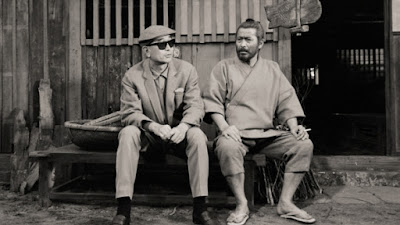Toshirô Mifune was an important movie star for those of us, like TrustMovies, who spent their adolescence and early adulthood in the thrall of foreign language films -- the likes of which we'd never before seen in our still-young lives. From 1947 through 1995, the actor made more than 182 movie and television appearances, though his international breakout hit, Rashomon, did not arrive until 1950. (Another of his most acclaimed performances, in Stray Dog, came one year earlier, but that film was not released in the U.S. until 1963.)
In the 2015 documentary MIFUNE: THE LAST SAMURAI, filmmaker Steven Okazaki (shown at left) gives those of us who revered Mifune -- who was the first and best of the many "strong, silent types" (Clint Eastwood, for example) who followed after him -- the opportunity to learn a lot more than we've previously known about the man, his life and times. Mifune was Japanese, all right, but he was born in China (to Japanese parents) and raised in Dalian. He never actually lived in Japan until he was 21 and WWII was well under way. He served in Japan's military and fell into acting, as so many post-war Japanese did as a way to better survive.
Okazaki's movie begins by telling us of the greatness of Mifune (shown above and below) and what might not exist without him. But can the film make the case for all this? We get some interesting information on the history and culture -- particularly regarding Japanese cinema -- that was new to me, at least, and what the early "ronin" movies meant to Japanese audiences, given their themes of heroism and sacrifice.
We hear from various actors and other movie professionals who worked with Mifune, from his son -- who tells us that it was his father's compassion that made him so rebellious -- and from everyone concerned about Mifune's long and hugely productive relationship with the great filmmaker and collaborator, Akira Kurosawa (below, left).
The two men made multiple movies together and then suddenly parted ways, never to return. The why of this is explored somewhat, but even with all hands on deck and offering possible reasons, we never learn but haltingly and marginally what actually happened between the two men, who died within a year of each other -- Mifune in 1997, Kurosawa in 1998.
We do learn that two of Mifune's favorite things were cars and alcohol, though neither seems to have had too much of an adverse effect. Along the way, we discover that Toho Studios, where many of Mifune's most famous films were made, had little understanding of how to use women in its films. (Yes, Ozu worked elsewhere.) Steven Spielberg and Martin Scorsese chime in at points with interesting thoughts and opinions.
Coming in at just 85 minutes, the movie never for a moment bores as it dances and skips along. But one might have wanted more length, as well as more depth, for overall exploration. By its end, however, it does answer the question posed in my third paragraph, above: It absolutely makes the case for Mifune as an original, a landmark performer and a great actor.
From Strand Releasing, and spoken in English and Japanese (with English subtitles), the documentary opens this Friday, November 25, at the IFC Center in New York City, and on December 2 at Laemmle's Ahrya Fine Arts in Beverly Hills and Landmark's Kendall Square in Cambridge, Massachusetts. It will hit another ten cities over the weeks and months to come and eventually appear in DVD. Click here and then scroll down and click on Screenings in the task bar to see all currently scheduled playdates with theaters and cities listed.











No comments:
Post a Comment